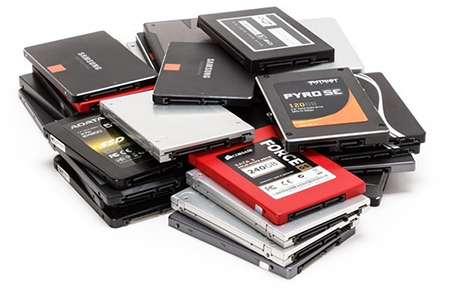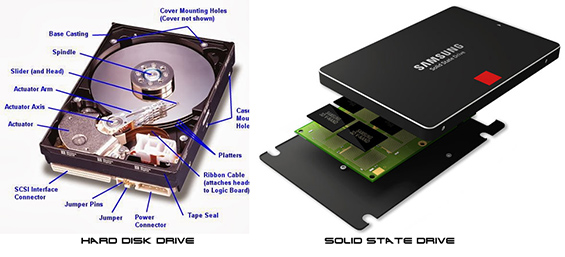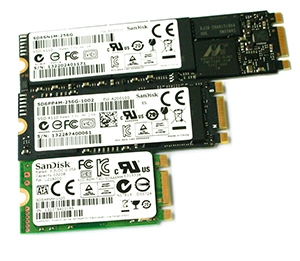
So what are they?
In simple terms they are a larger sized version of a flash memory stick, which is basically what they evolved from, that stores saved data in the same way a hard drive does. They interface via SATA and M.2 and are found inside a PC, unlike a USB flash stick, and have several advantages over a normal Hard Disk Drive such as being considerably faster.
So what makes them different to a normal HDD?
A “normal” Hard Disk drive is made up of multiple spinning disks (platters) that store data with a moving read/write head that passes over the spinning disks. A SSD (Solid State Drive), like briefly mentioned, utilises non volatile memory chips (Similar to RAM) which simply read and write without the use of a read write head, spinning platter or any moving parts for that matter. It is this lack of moving parts that distinguish them from a HDD (Hard Disk Drive).
This makes them more like RAM but with the major difference being that when you turn the power off the data remains (non volatile) unlike RAM where the data is reset/wiped (volatile).

History
Lately as SSD’s have come down in price and up in storage sizes they have now become much more prominent in custom built PC’s. In the past, SSD’s used to cost a lot whilst offering only a small amount of storage which put people off – A 60GB SSD was £120 less than a couple of years ago, compared to a 1TB HDD which was around £50. GB for GB the SSD worked out at £2 per GB whilst the normal HDD would give you a GB for just 5 pence. For your money, you would get 40GB of HDD storage for the same price as a single 1GB of SSD space.
Nowadays things have changed, a good quality 250GB SSD will set you back around £80 and a 1TB HDD £40. GB for GB it now costs around £0.32 for a GB of SSD space and £0.04 for HDD space. SSD’s are never going to hit the price of a normal HDD (certainly not in the next decade anyway) but they are now 1/6th of the price they once were making them exceptionally appealing.
Advantages - Speed
SSD’s are considerably faster than a HDD. Those mechanical parts of a normal hard drive introduce a delay in reading/writing data, with a SSD there is zero delay. This is known as “seek time” which is the time it takes for the head in a HDD to get to the desired data location through a combination of the moving head and spinning platter. A decent Hard drive will have an average seek time of around 8.5ms which may not sound like a lot, but data is never contiguously stored, meaning a hard drive may need to visit hundreds of physical locations to open a single file such as a Microsoft Word document. 100 multiplied by 8.5ms soon adds up. Remember back in the day when operating systems insisted on defragging your hard drive? Well it was because the operating system felt that your data was really fragmented and when you ran a defrag and it had finished, overall the system would have ran quicker and this was because the data had then been organized more contiguously.
In an ideal world data would be stored perfectly contiguously, even if you defragged your drive thousands of times, unfortunately it’s not the case and will never be the case. In case you were wondering, the reason why you don’t get asked by more modern operating systems if you wish to defrag your hard drive is because they already do it as default in the background. SSD’s don’t need to be defragged either – it takes the same time to access the data irrelevant of its location.
Furthermore a SSD’s transfer rate is considerably more than that of a good HDD. A Seagate Barracuda 7200RPM Desktop drive will have a Maximum sustainable transfer rate of 210MB/s, a decent SSD like a 250GB Samsung 850 EVO, 540MB/s! It doesn’t stop there, a M.2 interface SSD such as the Samsung 512GB 950 Pro has a maximum sustainable transfer rate of 2,500MB/s! That’s nearly 12 times faster than a normal hard drive!
Advantages – Heat
No moving parts means a SSD generates considerably less heat than a normal hard drive. Granted this is not going to be high up on your list of needs but it will bring the overall system temperatures down slightly and SSD's will happily passively cool themselves where as a HDD ideally should have a slight amount of air moving over them.
Advantages – Power Requirements
Again a similar situation to heat, no moving parts means a SSD will use less power lowering the overall requirement for the entire PC. Again, it’s not a deal breaker and should not influence your SSD v HDD decision but it’s worth a mention.
Advantages – Reliability
SSD’s are reliable, like really reliable! Traditionally a normal hard disk is one of the more common components to fail on a PC – like any device, the more moving parts the more chance of something going wrong. This being said, Seagate Hard drives like we use are the most reliable of the bunch which is firstly why we use them and why you should never trust an unbranded hard drive. Due to the lack of moving parts in a SSD the failure rate of them is considerably lower than that of a hard drive.
Advantages – Size
Platters and heads take up space, memory chips don’t. A Desktop hard drive measures around 20mm x 100mm x 147mm (H x W x D) whilst a SSD measures 6.8mm x 70mm x 100 (H x W x D) and a m.2 SSD is even smaller typically measuring just 2.38mm x 22.15 x 80.1 (H x W x D).
The weight is also different, a desktop Hard Drive, depending on its capacity will weigh anywhere in between 400g (1TB) to 780g (6TB), whilst a SSD will at most be 66g and a m.2 SSD just 10g!
This size, weight, heat and power requirements mean they can be crammed into smaller systems such as laptops, tablets, mobile phones and M-ITX systems as well as proper full fat desktops.
M.2 Interface

As previously described, M.2 SSD’s are considerably faster than a SATA SSD. M.2 Slots are found directly on a motherboard rather than a drive that sits in a bay and is connected via a SATA and power cable. Intel X99, B150, Z170 chipset motherboards commonly have a M.2 slot, older motherboard generally don’t. It’s a move to signal the popularity of M.2 Devices and we predict this will be a standard feature on most new Intel and AMD Chipsets.
Application
Whilst a PC game is not going to look any prettier with a SSD, it will load faster and performance will be improved in open world games when the game requires loading large areas of a map at once, but a SSD uses are greater than that of a PC game. The main use for them is to load an operating system and commonly used, if not all, software and programs to them. Running your copy of Windows installed to a SSD is a similar difference to night and day, overall responsiveness is vastly improved, so is opening that folder with several files, scooting around using your favourite internet browser or firing up the latest version of Photoshop will see a huge reduction in load times.
Working with large files for video editing, rendering, photo editing, compiling code, encoding or just un zipping something will all take advantage of the blistering speeds a SSD offers again to a level of difference between black and white.
There is no doubt SSD’s advantages are worth having, the decision to own one is purely a cost choice. Once you have settled on a good quality system matching your requirements is there any left over to buy a SSD? Generally SSD’s get added to systems around the £1000 and upwards, up to £1000 there are areas where your cash can be put to better use although if you need/want fast storage then you should place this requirement further up the list.
Unless you are opting for 1TB or possibly 500GB your SSD is probably not going to be your only storage drive, the most common thing to do is to run a smaller 120/250/500GB SSD as the primary drive where all your programs and operating system and common games are installed and then to run a second larger storage drive for storing everything else.
SSHD’s
As SSD’s cost more than a normal hard drive it brought upon the birth of a SSHD – Solid State Hybrid Drive and it is exactly as the name suggests, A Hybrid drive that consists of a large HHD like capability but with a small amount of SSD (usually around 8GB) too. The idea is the system moves everything to the SSD area of the drive that is commonly used and the not so popular files end up on the HDD side of the SSHD.
The idea is to use them in systems where the customer cannot afford a SSD/SSD & HDD combo or in systems which only have room for a single hard drive such as a laptop. In theory, it’s a great idea but in practice it fails, hard. Read/write speeds are not improved and are less than that of a HDD and you pay a premium for this! Steer clear of them.


